Introduction
In the rapidly evolving landscape of mobile applications, understanding and leveraging key metrics is paramount for developers and marketers alike. Mobile app metrics not only illuminate user behavior and engagement but also serve as critical indicators of an app's overall effectiveness and financial health.
From tracking user retention and churn rates to analyzing revenue generation through metrics like Average Revenue Per User (ARPU), these data points provide invaluable insights that can shape strategic decision-making. As the competition intensifies, the ability to dissect these metrics becomes essential for enhancing user satisfaction and driving growth.
This article delves into the various categories of mobile app metrics, offering a comprehensive overview that equips stakeholders with the knowledge needed to optimize their applications and thrive in a crowded marketplace.
Understanding Mobile App Metrics: An Overview
Mobile app measurements act as key metrics for mobile apps, serving as critical indicators that empower developers and marketers to evaluate their applications' performance. These measures provide valuable insights into individual behavior, engagement levels, and the overall effectiveness of an application. By understanding the various types of measurements, stakeholders can make data-informed decisions that improve app enhancements and increase customer satisfaction.
Notably, the key metrics for mobile apps encompass:
- User engagement
- Revenue generation
- Retention rates
- Technical performance
Each category is pivotal to assessing an application's success and longevity in an increasingly competitive landscape. For instance, portable photo and video applications are the second most popular category, with nearly 20 billion downloads per year, illustrating the vast market potential.
Additionally, the case study of Threads, which experienced a significant decline of 70.45% in daily active participants, highlights the challenges new platforms face in maintaining engagement. Additionally, Bluesky's accomplishment of reaching 1 billion downloads globally as of July 7, 2023, highlights recent trends and successes in the app market. The significance of these key metrics for mobile apps cannot be exaggerated, as they lay the groundwork for enhancing experience and fostering growth in the app ecosystem.
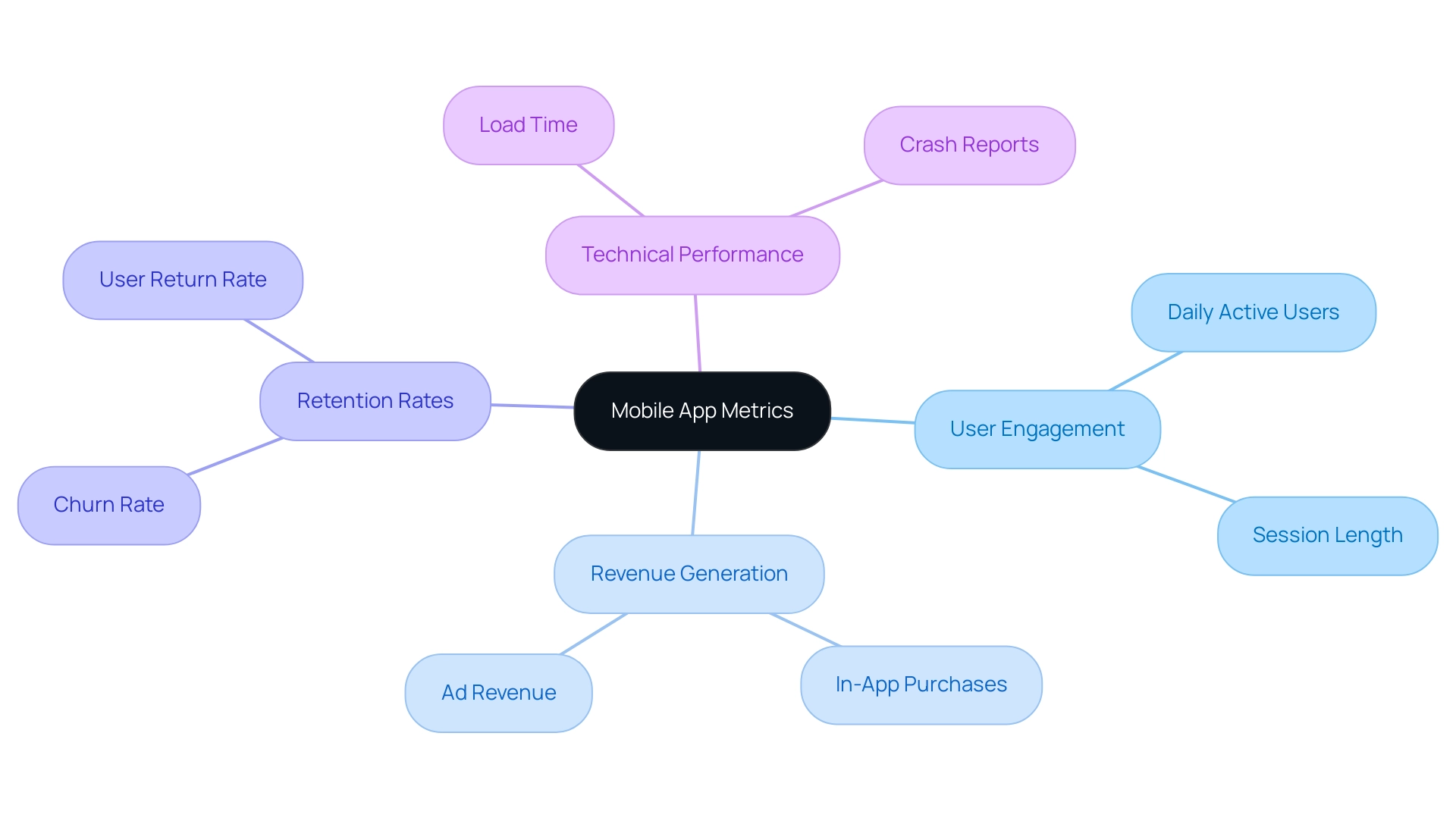
Key User Engagement Metrics: DAU, MAU, and Beyond
Engagement metrics, notably Daily Active Users (DAU) and Monthly Active Users (MAU), are considered key metrics for mobile apps that indicate how frequently individuals interact with a mobile application. DAU reflects the number of distinct individuals engaging with the app daily, while MAU captures the unique participants over a month-long period. High DAU and MAU values signify robust interest and retention, which are pivotal for any app's success.
As emphasized by industry specialists, understanding key metrics for mobile apps like DAU and MAU is essential for app developers as these measures directly affect business strategies and app improvements. Additionally, metrics such as session length and frequency of use provide invaluable insights into individual behavior. For instance, a longer session length often correlates with higher satisfaction and engagement, allowing businesses to refine their marketing strategies and elevate the overall experience.
Recent statistics show that:
- Google Play Store downloads grew by 31%
- Apple App Store had a 2.5% growth rate
This indicates a dynamic mobile app landscape. Furthermore, gaming apps account for 28% of the apps available in China, highlighting a significant segment of the market. By carefully examining the key metrics for mobile apps, companies can identify trends, improve client retention, and ultimately increase app profitability.
Case studies, including the comparative presence of social media platforms, showcase how successful companies have utilized engagement statistics to enhance their app experiences, reinforcing the critical role that DAU and MAU play in driving profitability and customer loyalty.
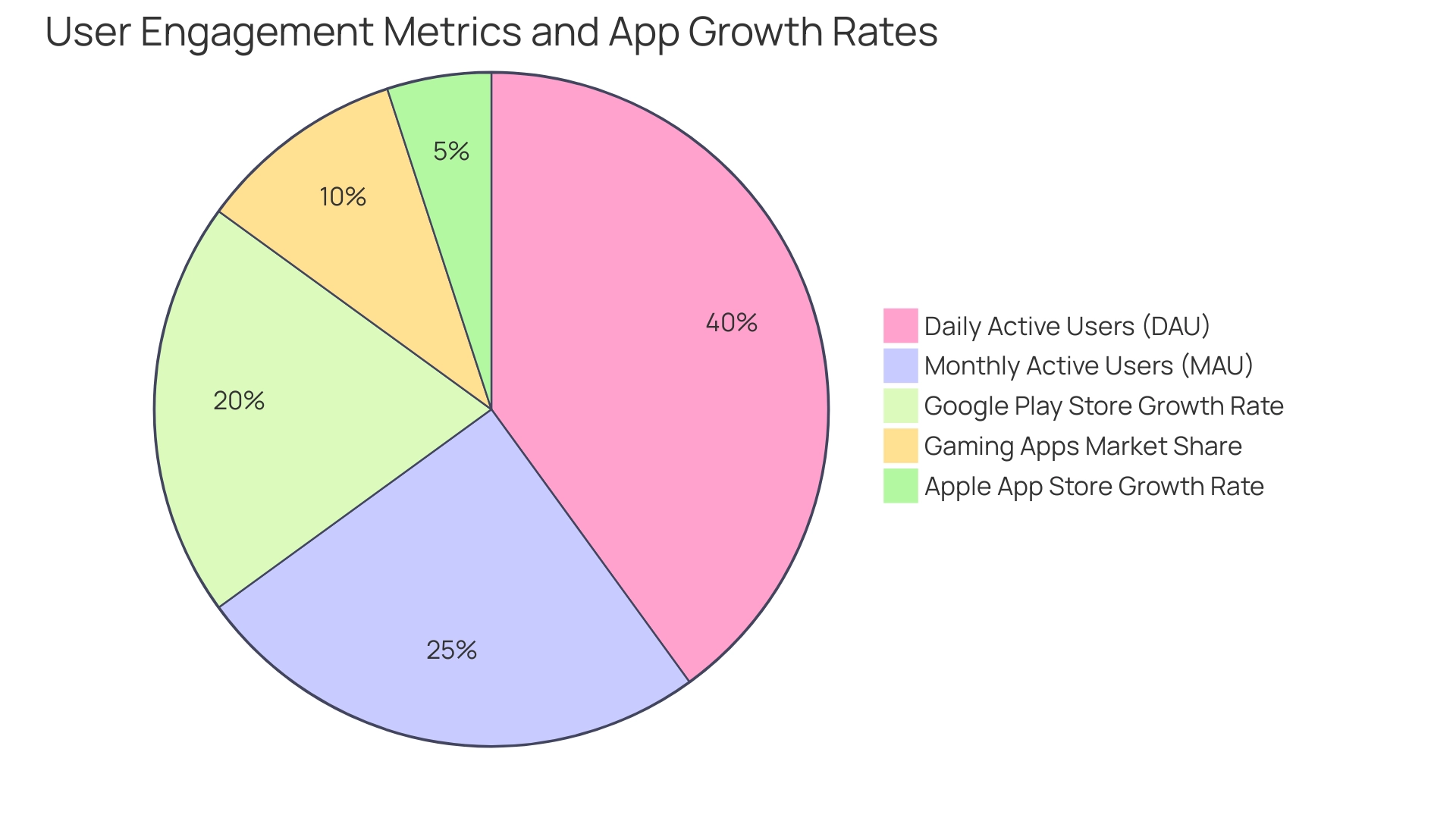
Revenue Metrics: Measuring Financial Success in Mobile Apps
Revenue measurements are essential indicators of key metrics for mobile apps, reflecting an app's financial health and providing insights that guide strategic decision-making. Average Revenue Per User (ARPU) is one of the key metrics for mobile apps that calculates the revenue generated per individual, allowing businesses to assess the effectiveness of their monetization strategies. In 2024, industry statistics show that applications continue to evolve, with a significant shift toward improving engagement and profitability.
With social media showcasing an audience of 5.17 billion individuals, the potential for mobile apps to capitalize on this vast engagement is significant. Customer Lifetime Value (LTV) is one of the key metrics for mobile apps, as it further enriches this analysis by estimating the total revenue an individual is expected to generate over their lifetime with the app. For instance, the case study titled "Impact of Social Media on Brand Awareness" highlights how brands can enhance visibility through compelling content that resonates with their target audience, thus increasing their ARPU.
By thoroughly analyzing the key metrics for mobile apps, companies can make informed choices regarding their marketing expenditures, identify and focus on lucrative audience segments, and adjust their monetization strategies accordingly. Tools such as iScripts Socialware Enterprise enable companies to establish branded social networks, boosting community development and brand loyalty, which directly relates to the significance of engagement statistics in mobile applications. For example, an app exhibiting a high LTV may warrant higher customer acquisition costs, justifying investment in more aggressive marketing tactics.
Conversely, a lower ARPU could signal the need to reassess pricing strategies or optimize in-app purchases, ensuring that the app remains competitive by focusing on key metrics for mobile apps where experience and revenue generation are paramount.
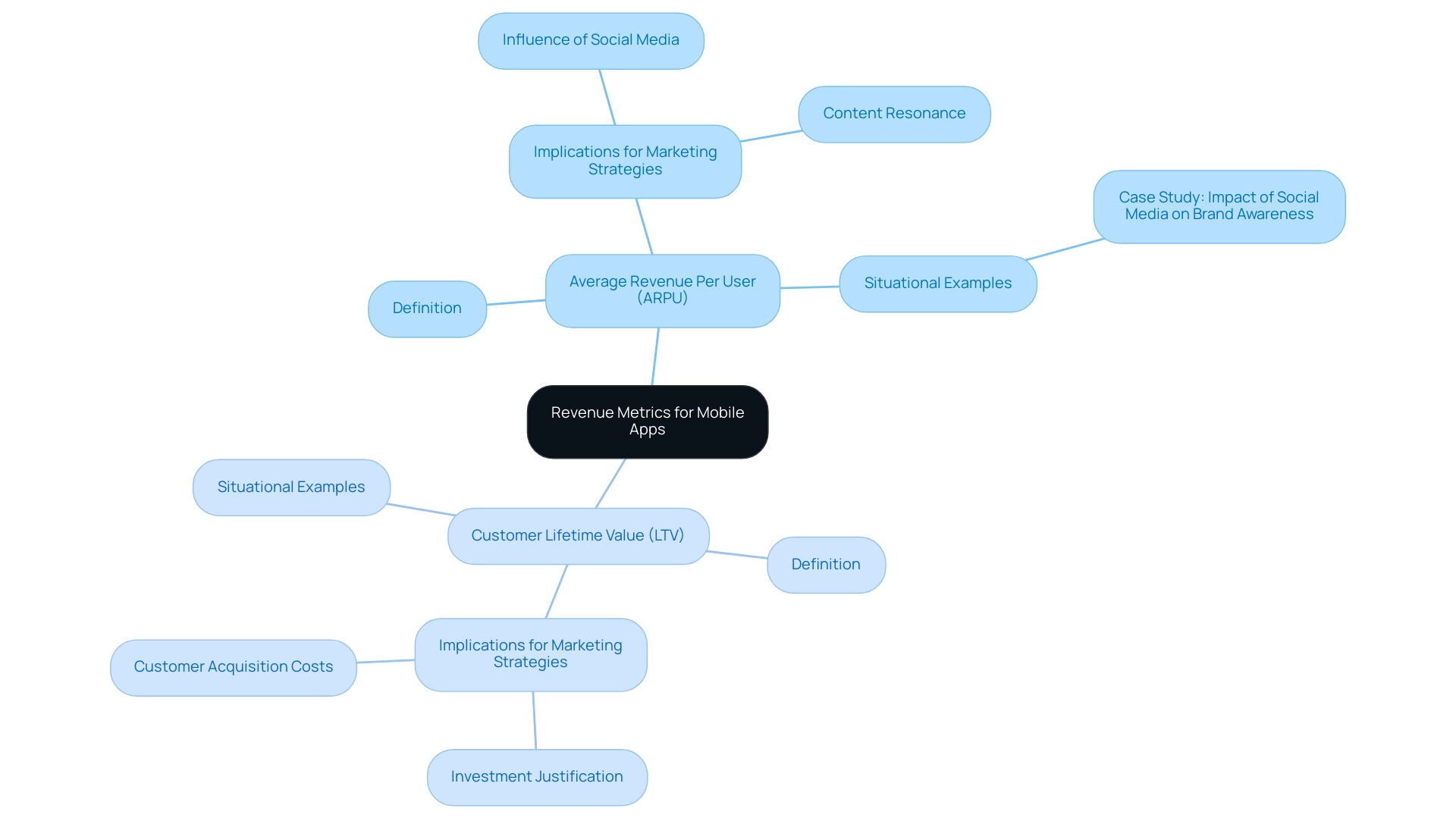
Retention and Churn: Indicators of App Longevity
Retention and churn metrics are considered key metrics for mobile apps, serving as critical indicators of an app's longevity and customer loyalty. The retention rate reflects the percentage of individuals who continue to engage with the app over a specified period, while the churn rate represents the percentage of individuals who discontinue use. High retention rates, which are among the key metrics for mobile apps, suggest that individuals find substantial value in the app, whereas elevated churn rates may indicate dissatisfaction or the availability of superior alternatives.
Recent studies reveal a concerning trend: more than 90% of individuals typically disengage before reaching day 30, with average retention rates plummeting to 2.1% on Android and 3.7% on iOS by that time. On day one, average retention rates are 21.1% for Android and 23.9% for iOS, illustrating a significant drop in engagement. This stark reality underscores the necessity for developers to analyze key metrics for mobile apps proactively, identifying pain points in the experience that could be addressed to foster a more loyal base.
As Growth Lead Jonas Kurzweg notes,
Learn to leverage behavioral cohort analysis to boost retention, tailoring strategies to actions for enhanced app engagement.
Strategies to enhance retention may include:
- Personalized notifications
- Loyalty programs
- Regular content updates that keep individuals actively engaged
Moreover, lowering the churn rate by just 4% can lead to an impressive increase in revenue, estimated at $11,150 within six months.
Given the significant impact that churn rates can have on an app's success, as highlighted by the high churn rates seen across various app categories—where news apps exhibit the highest retention and Photo & Video apps the lowest—it is essential to implement targeted retention strategies to enhance the key metrics for mobile apps.
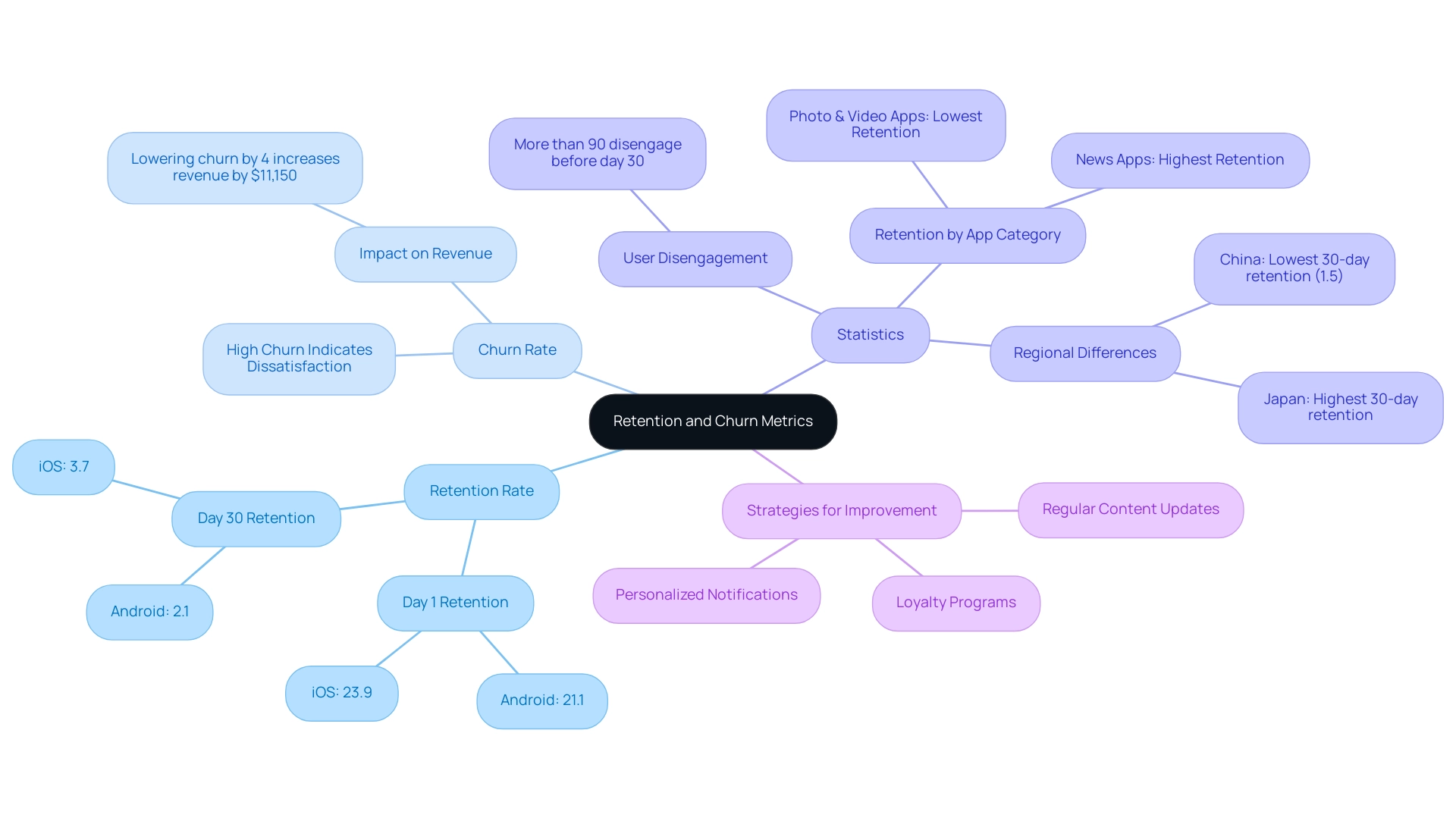
Technical Performance Metrics: Ensuring a Smooth User Experience
Key metrics for mobile apps, particularly technical performance metrics, play a crucial role in delivering a seamless experience and ensuring the reliability of applications. Key performance indicators are considered key metrics for mobile apps, including:
- App load time
- Crash rates
- Response times
Research indicates that slow load times can frustrate individuals and significantly increase churn rates.
In fact, 74% of visitors are more inclined to return to a website that provides a positive mobile experience, emphasizing the necessity for optimization. Furthermore, 75% of individuals assess a website's credibility based on its aesthetics, highlighting the necessity for visually appealing designs to build trust and encourage engagement. Frequent crashes can severely tarnish an app's reputation, making it essential for developers to closely monitor the key metrics for mobile apps.
By identifying performance bottlenecks, optimizing code, and enhancing server capacity, developers can significantly improve app reliability. Implementing strategies such as:
- Optimizing image sizes
- Utilizing a Content Delivery Network (CDN)
- Minifying code
- Incorporating browser caching
can lead to remarkable reductions in load times—up to 70% with Gzip compression alone. Notably, the case study titled 'Strategies to Improve Page Load Time' demonstrates that these approaches can substantially enhance overall experience.
Additionally, businesses are increasingly preferring cloud-based testing infrastructure to avoid the high costs associated with in-house labs, further emphasizing the importance of efficient performance testing. Regular performance testing and updates are imperative to maintain high technical standards, ultimately enhancing user satisfaction and retention. Users are more inclined to engage with an app that consistently provides a smooth and reliable experience, highlighting that key metrics for mobile apps are not just important, but essential for success in the competitive mobile landscape.
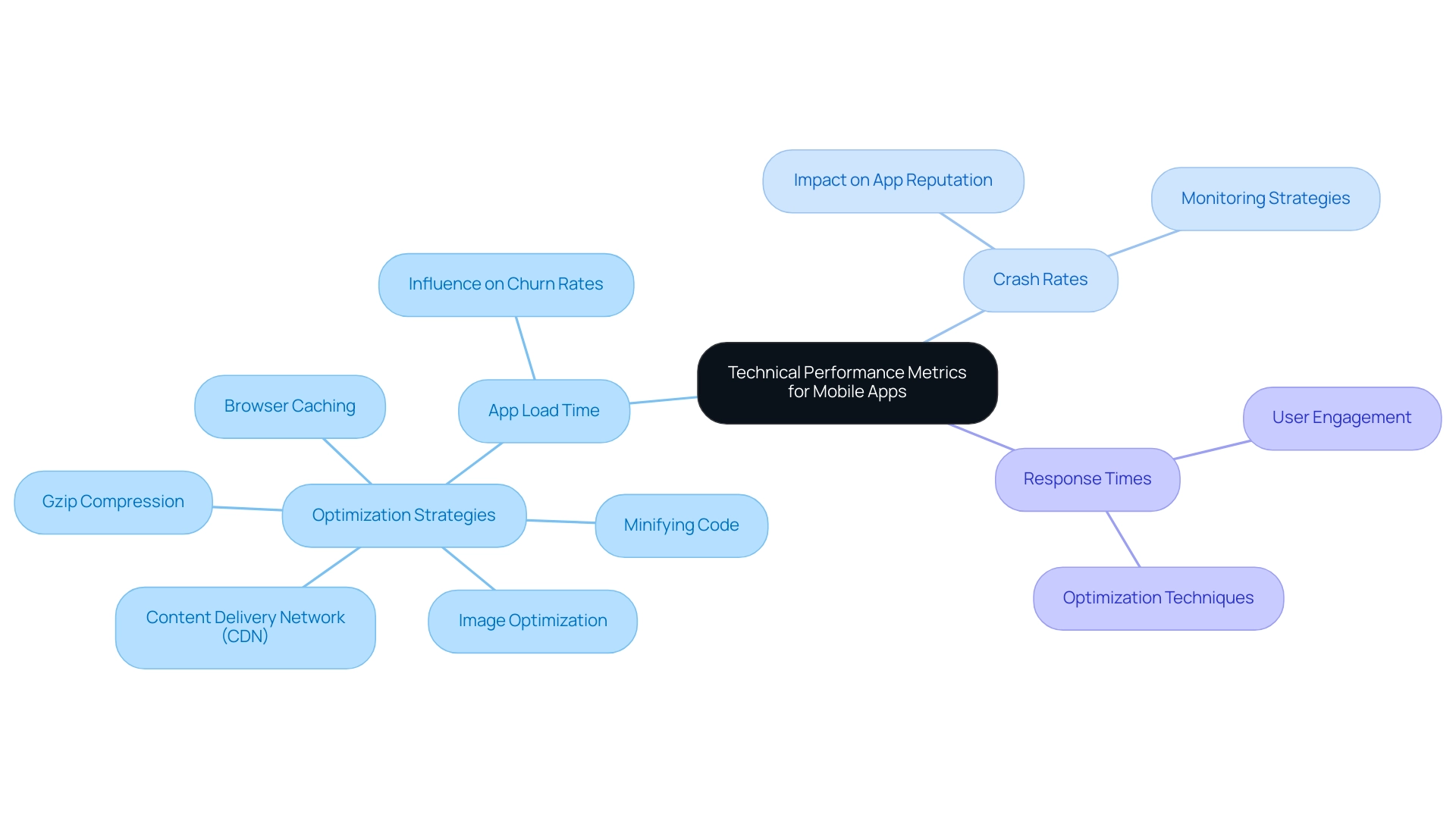
Conclusion
Understanding and effectively utilizing mobile app metrics is crucial for developers and marketers aiming to thrive in a competitive landscape. By dissecting key categories such as:
- User engagement
- Revenue generation
- Retention rates
- Technical performance
stakeholders can gain invaluable insights into user behavior and app effectiveness. Metrics like Daily Active Users (DAU) and Monthly Active Users (MAU) provide a clear picture of user engagement, while revenue metrics like Average Revenue Per User (ARPU) and Customer Lifetime Value (LTV) highlight financial success and potential growth areas.
Moreover, retention and churn rates offer critical indicators of user loyalty, emphasizing the importance of maintaining a satisfied user base. The stark reality of user disengagement, particularly in the early stages of app usage, underscores the need for proactive strategies to enhance retention. Additionally, technical performance metrics are vital in ensuring a smooth user experience, as they directly impact user satisfaction and engagement levels.
In conclusion, the ability to analyze and act upon these metrics is not just beneficial but essential for optimizing mobile applications. By leveraging these insights, businesses can make informed decisions that enhance user experience, drive growth, and ultimately secure a more favorable position in the crowded mobile app marketplace. Embracing a data-driven approach to app development and marketing will pave the way for sustained success and user loyalty in an ever-evolving digital landscape.





